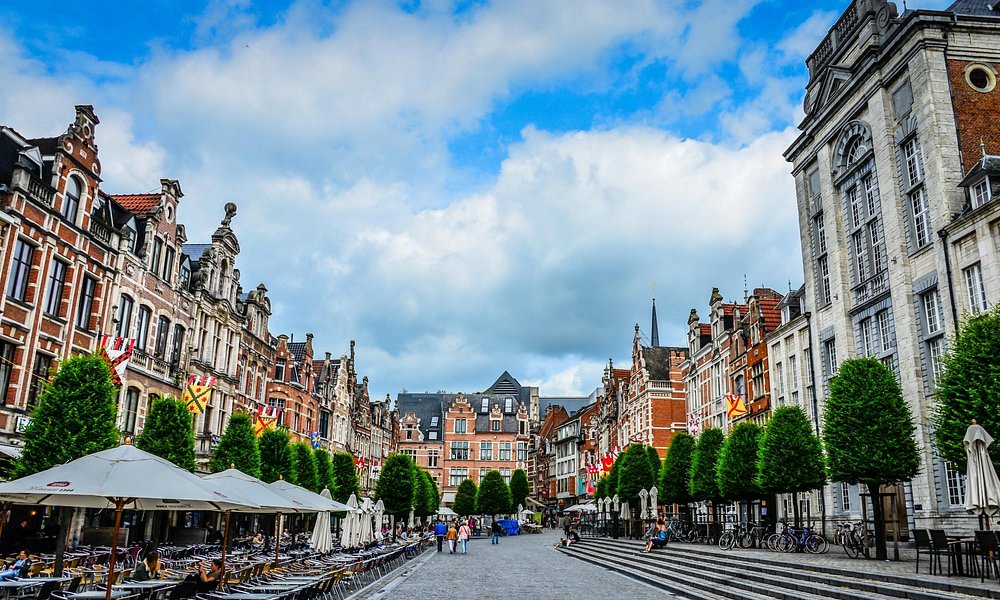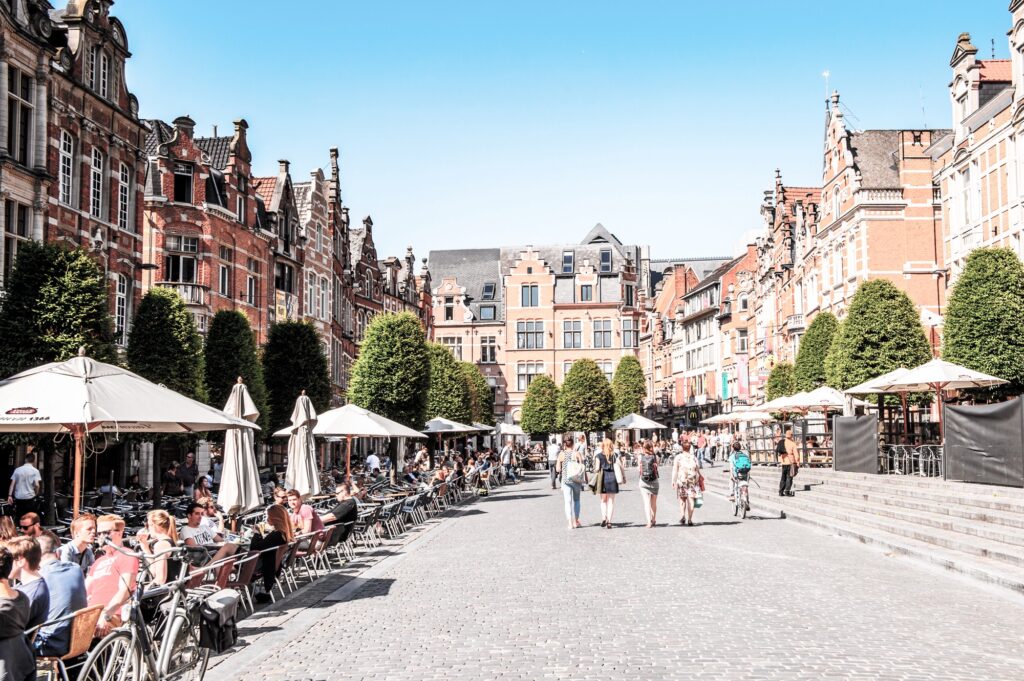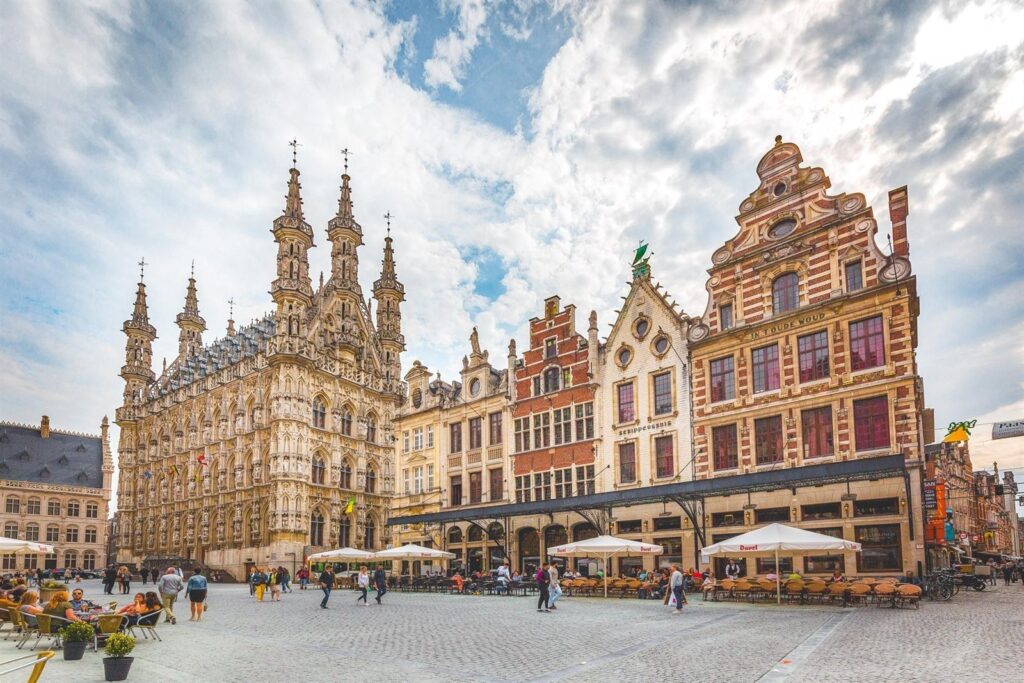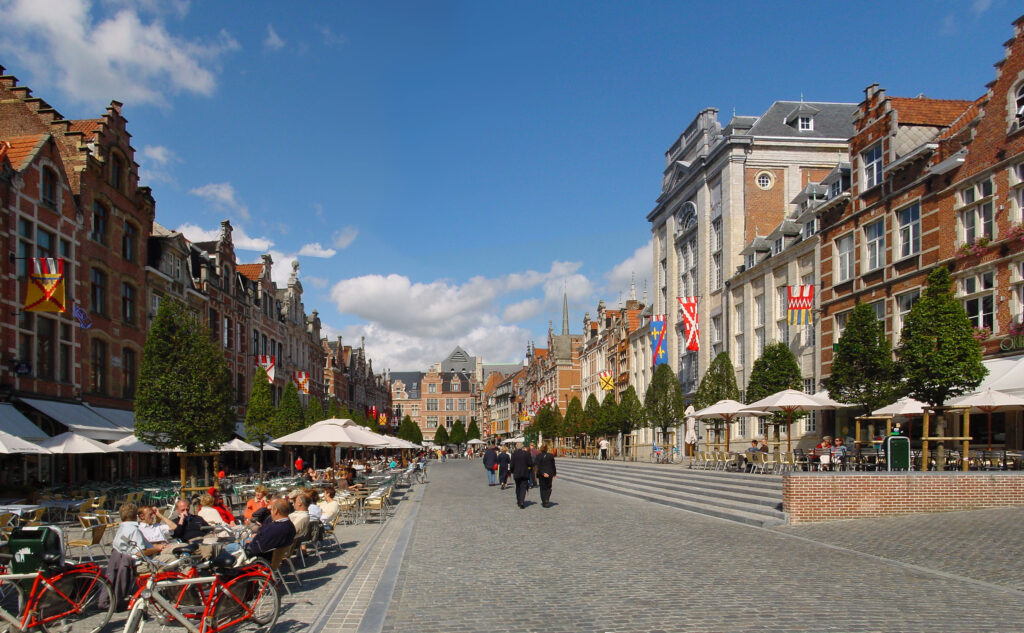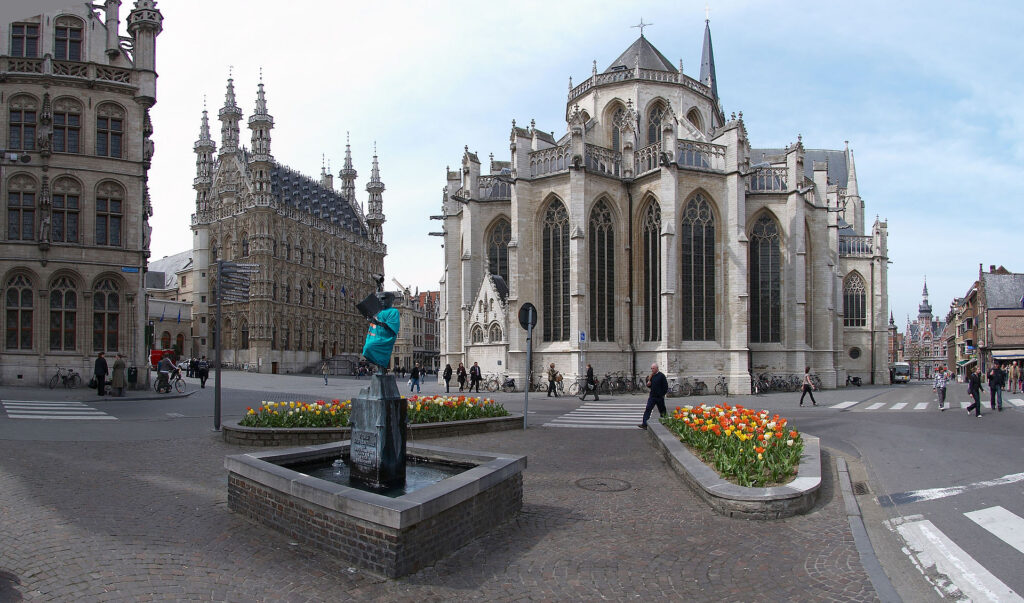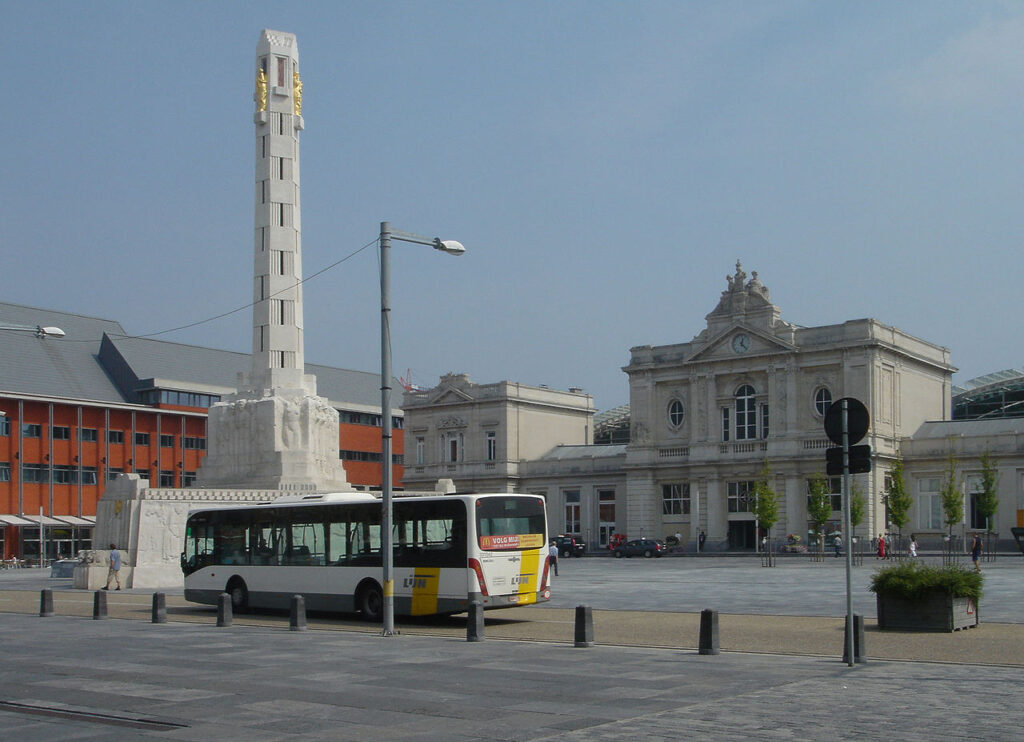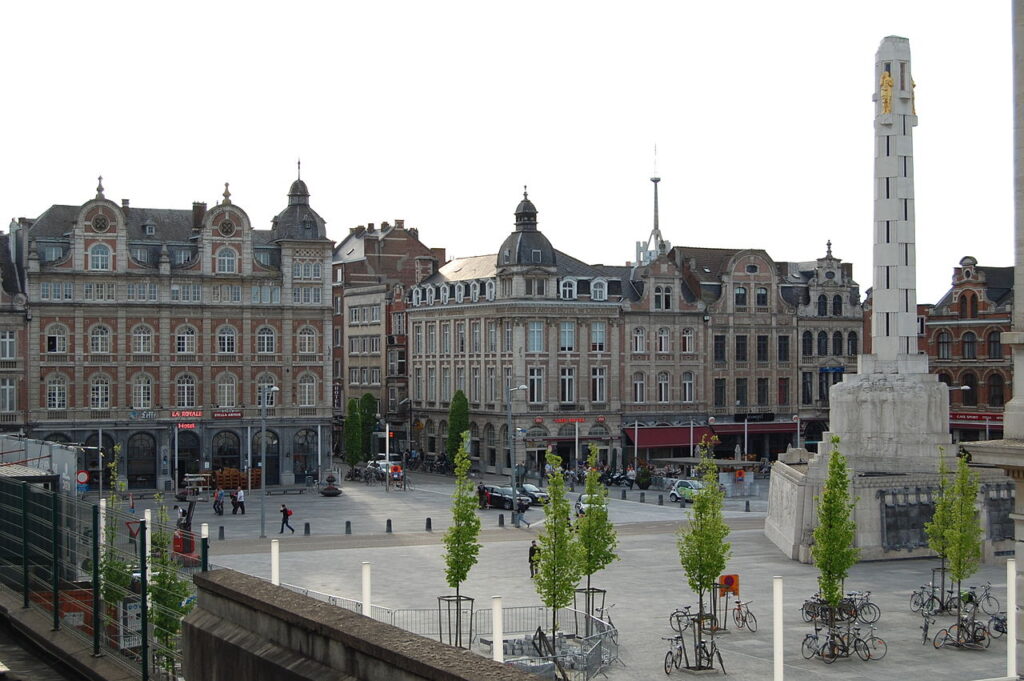Leuven is the capital and largest city of the province of Flemish Brabant in the Flemish Region of Belgium. It is located about 25 kilometres (16 miles) east of Brussels.
| Country | Belgium |
|---|---|
| Community | Flemish Community |
| Region | Flemish Region |
| Province | Flemish Brabant |
| Arrondissement | Leuven |
| Government | |
| • Mayor | Mohamed Ridouani |
| • Governing party/ies | SP.A, Groen, CD&V |
| Area | |
| • Total | 56.63 km2 (21.86 sq mi) |
| Population | |
| • Total | 101,396 |
| • Density | 1,800/km2 (4,600/sq mi) |
Sights
Secular
- The Town Hall, built between 1439 and 1463 by Sulpitius van Vorst, Jan II Keldermans, and following their death, Matheus de Layens, in a Brabantian late-Gothic style.
- Arenberg Castle was originally built in 16th century in the Renaissance style and was extensively renovated in the Neogothic style in the 19th century.
- The Linen-hall, in an early-Gothic style, with baroque addition, is today the University Hall.
- The University Library on the Ladeuzeplein was built by the American architect Whitney Warren. It was a gift from the American people to Leuven after World War I, during which the Germans burned down the original library. The tower houses one of the largest carillons in the world.
- The Oude Markt or Old Market square located in the centre of Leuven features a vibrant social scene, the centre of which displays a life-size statue of ‘De Kotmadam’, or “The Landlady” resting on a bench.
- Sint-Donatus Park contains remains of the medieval city wall.
- Totem is a statue at the centre of the Ladeuzeplein; it is a work of the Belgian artist Jan Fabre. Featuring a 23-metre-high needle impaling a giant jewelled beetle, the statue towers over the square in front of the university library.
- Fonske is a statue near the centre of town. Its full name is Fons Sapientiae, Latin for “fountain of wisdom”. The statue represents a university student who, while reading a book, lets wisdom flow into his head as liquid from a glass. Just like Manneken Pis in Brussels, Fonske is, from time to time, dressed in costumes appropriate for specific occasions.
Religious
- St. Peter’s Church was finished by Jan Keldermans and Matheus de Layens. During the Second World War, the church was damaged. During the restoration, a Romanesque crypt from the 11th century was found.
- Saint-Anthony’s Chapel, Pater Damiaanplein, from the 17th to the 20th centuries, contains the tomb of Father Damien, the “leper priest” of Molokai, who was canonised by Pope Benedict XVI on Sunday 11 October 2009.
- The Church of Saint Michael was built in the typical Jesuit Baroque Style.
- The Saint Quentin’s Church incorporates remains of a Romanesque church built in the 13th century.
- The Large Beguinage is one of the world’s best remaining examples of its architectural type. It was recognised by UNESCO as a World Heritage Site in 1998.
- Park Abbey, a 42ha Premonstratensian Abbey founded in 1129 and manufacturing site of the Parc Abbey Bible. It is one of the best preserved abbey complexes in the Low Countries and is still inhabited by a small community of Canons regular.
- Keizersberg Abbey, an active Neo-Romanesque Benedictine Abbey founded in 1888. It is situated on the Keizersberg (“Emperor’s Mountain”) which used to be the location of a 12th-century ducal castle until it was demolished in 1782.
- Vlierbeek Abbey, a former Benedictine abbey founded in 1127.
- Sint-Geertrui Abdij, a former Augustinian abbey founded in 1206.
- Lerkeveld is a Jesuit house, student residence, and headquarters of the Society of Jesus in Belgium.
- The Al Fath mosque was built in 2016 and is used as a mosque where people can pray.
- Al Ihsaan is a government-funded mosque that was found in 1976 and that is still actively used as a place for people to pray. Al Ihsaan also offers Arabic lessons.
- There are several other smaller churches and chapels throughout the town.
Colleges
The Old University of Leuven used to have 40 constituent colleges and 4 pedagogies, some of which are still being used by KU Leuven. The most notable ones are:
- Holy Ghost College, founded in 1442, currently a residence for theology students and priests at KU Leuven.
- Collegium Trilingue, which promoted the teaching of Hebrew, Greek and Latin. It was founded in 1517 by the humanist Hieronymus Busleyden under impulse of Desiderius Erasmus and served as a model for France’s Collège de France.
- Pope’s College, a college for theology students of the Old University of Leuven founded by Pope Adrian VI in 1523.
- St Anthony’s College, founded in 1607, was located on the Pater Damiaanplein and has been a centre of Irish learning on the European Continent since the early 17th century.
Culture
One of Belgium’s conservatories is based in Leuven: the Lemmens Institute, which is described as “Faculty of Music, Performing Arts and Education”. It is known for its music therapy education and its wordart-drama education. Kunstencentrum STUK is a cultural centre and venue in the city center for music, theatre, sound art, and dance. Leuven holds a summer rock festival, Marktrock. Leuven has some university orchestras, such as the University Symphony Orchestra, the University Symphonic Band.
In September 2009, the M – Museum Leuven opened in Leuven. It is a museum for both contemporary and historical art, located near het Ladeuzeplein. It has hosted exhibitions by international artists such as Angus Fairhurst, Sol LeWitt, Roe Ethridge and Charles Burns as well as Belgian artists such as Ilse D’Hollander, Jan Vercruysse, Antoon Van Dyck and Freek Wambacq.
Leuven has a rich beer culture, being the birthplace of several beers such as Stella Artois, Leuvense Tripel, Domus and Keizersberg. It has several bars priding themselves in offering a wide variety of local and international beers, including a bar that claims to offer more than 3000 different beers.
Eat
In general, you’d have to really make an effort to find a horrible meal in Leuven. Almost all restaurants are tasty and relatively cheap, given the student population.
- There are many good eateries and a great atmosphere (eating outside during the Summer is a can’t-miss!) in the Muntstraat, very different styles from classical French Belgian cuisine to “Mexican”, Italian, Vietnamese, Chinese and Japanese. Consult the brand new website for more information.
- More common, bigger restaurants can be found right next to City Hall on the Grand Place.
- Domus, on the corner of Tiensestraat and Eikstraat, is a cosy bar-restaurant renowned for the house special ‘Retro Spaghetti’ and the howebrewed beers ‘Con Domus’ (blond) and ‘Nostra Domus’ (amber), which are only sold here.
- The area around the Oude Markt (Old Market) and Parijsstraat has many smaller restaurants and bars, the Old Market is sometimes called the longest bar in Europe.
- The Martelarenplein houses a lot of restaurants and bars just a stone’s throw away from the railway station.
- Look for cheaper restaurants on the Old Market, as that’s where the student population mostly enjoys their meal.
- Try fresh North Sea Mussels, during their season (roughly August-March). Every year, you’ll see the big signs announcing their arrival in front of many restaurants.
- Many Belgians enjoy french fries and snacks in a Frietkot if they’re looking for a quick and cheap bite. Don’t leave Belgium until you’ve tried it!
- Zoff (by Max) +
- A cheap and tasty option is Kiekekot Çetin Simsek, a Kurdish-origin activist of the Flemish Socialist Party SP.a. will welcome you and provide with fresh beers and roasted chicken with herbs.
- Traiteur Kapucijnis a lovely and cheap place with fresh broodjes (sandwitches, baguettes). So you may grab something from this place and enjoy it on a bench or at a picnic table in the lovely garden.


